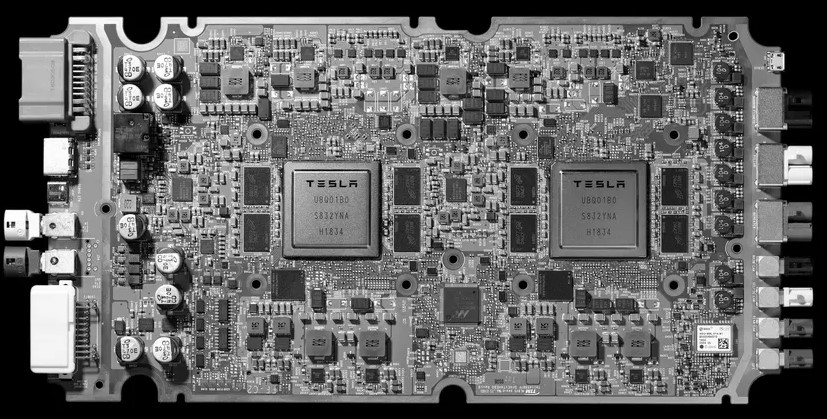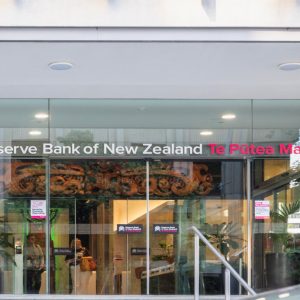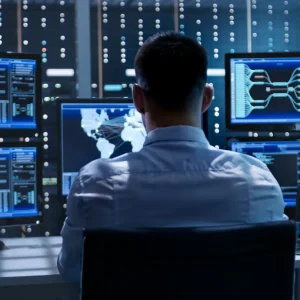
Tesla has unveiled a new chip and computer for its cars custom designed by a team led by Apple veteran Pete Bannon. The hardware started full production in July 2018 and is already being retrofitted to employee vehicles, CEO Elon Musk said at the company’s first “Autonomy Day” – intended to showcase autonomous driving progress. Tesla has dropped NVIDIA’s products as a result.
The release came at an event characterised by a fresh series of bold claims by the mercurial CEO, including that Tesla would be able to make cars without pedals or steering wheels within two years and that there would be one million “robo-taxis” on the roads by 2020. While Musk has pulled some rabbits from his hat before, incidents like his notorious “funding secured” (to take Tesla private) tweet have left analysts and investors wary of such grand promises.
“NVIDIA is a great company” said Musk, “but they have many customers. So when they apply their resources they need to a generalised solution. We care about one thing: self driving.” (NVIDIA admitted to Bloomberg that Tesla had “raised the bar”.)
 Tesla Chip: The Backstory
Tesla Chip: The Backstory
As Bannon put it in a detailed presentation: “In 2016 there was no ground-up neural network accelerator; everyone was adding instructions to their CPU or GPU or DSP to make it better for inference”.
The company decided to design one from the “ground-up” as a result.
As he told analysts and investors: “I was hired in Feb 2016. I asked Elon if he was willing to spend all the money it takes to do full custom system design.” He said ‘are we gonna win?’ and I said ‘of course’ so we got a bunch of people and got to work.”
The Tesla chip, built for the company by Samsung, is capable of 76 trillion operations per second (TOPS). It draws just 100 watts and includes what Bannon described as a “modest” GPU, with the aim being that as the neural net improves performance, the amount of post-processing the GPU does will shrink. The computer includes 12 A72 64-bit CPUs for general purpose processing that operate at 2.2. gigahertz.
Read this: The Myths of Driverless Cars and Our Push for Autonomous Vehicles
The company has been training its neural network using real-world interactions and tests it using what Tesla calls “shadow mode”, during which the car sees a vehicle that’s about to change lanes and it makes a note of what it would have done. The data is sent to Tesla which assesses it for false positives and retrains the system accordingly.

The Tesla event came days after research house Forrester published a research paper assessing the outlook for autonomous vehicles (AVs).
The paper, underpinned by an industry survey, found that costs were the biggest single challenge for those in the sector, at 22 percent.
Hardware and compute challenges combined rank as the top priority for 28 percent of respondents. System speed, power demands, compute power, system cooling, and system size were all deemed major ongoing challenges.
Tesla says its new system markedly brings costs down. Unlike other cars developing AVs it continues to insist that its single forward radar and surround cameras are sufficient for its vision-based autonomous drive system; another cost-saving. (Waymo, for example, uses four radar units for 360 degree coverage as well as short, medium and long-range LIDAR units on top of surround cameras, by contrast).
Tesla’s team say its new processor is the only hardware upgrade needed to achieve Level 5 autonomy.
Robert Day, Director of Automotive Solutions & Platforms, Arm, noted in response to the Forrester report: “The deployment of the first truly self-driving cars are likely to be restricted, such as cars only operating in pre-defined (and well-mapped) areas, in certain environmental conditions (e.g. daytime, dry conditions) and at limited speeds. This is, by the letter of the SAE law, Level 4. Then, we’ll see a gradual roll-out as trust builds through compute advances and artificial intelligence becomes more ‘intelligent’”.

 Tesla Chip: The Backstory
Tesla Chip: The Backstory 




